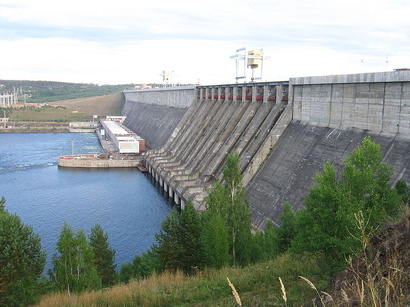Rogun HPP construction, matter of dispute among experts

By Aynur Jafarova
“To be or not to be" was the question remains to be a dilemma in all the beginnings of a man.
The construction of Rogun hydro power plant (HPP) has become one of the major disputes among the experts representing Central Asian countries.
The issue is obvious: all want cheap electricity, but at the same time they want to evade the bad impacts of this facility on the environment.
The construction of Rogun HPP is a matter of life and death for Tajikistan, which is in urgent need of energy. Although it is located in an energy-rich region, the country faces energy-related problems.
Tajikistan is literally plunged into darkness and cold during the winter period when rural Tajik consumers receive electricity on an average five to seven hours per day. The existing hydro-power facilities are unable to meet the demands.Lack of electricity in the absence of developed large deposits of hydrocarbons has led to the imposition of a limit on the consumption of electricity. As a result, homes remain without electricity and people have to heat their homes only through two-thirds of the day.
The economy and the social sectors suffer from this problem as well. Due to lack of energy in the country, many enterprises work only seasonally due to the energy deficit. The activity of the majority of industrial enterprises, in particular small and medium-sized businesses, generally freezes for a few months.
Tajik President Emomali Rahmon has set a goal for the energy sector of the country: to construct Rogun HPP.
The Rogun Dam, the construction plan of which dates back to the 1960s, was one of the three proposed hydro power projects on the Vakhsh River. Nurek and Sangtuda were accomplished, but Rogun was not. The Rogun Dam is planned to be 335 meters high with a capacity of 3,600 megawatts per year. If constructed, the Rogun Dam will be the tallest dam in the world.
The Rogun HPP is seen in Tajikistan as a solution to the energy problem and a tool for economic growth. If the project is implemented, Tajikistan will be able to generate about 13 billion kilowatt-hours of electricity annually. This will not only help the country to meet its domestic needs but also make Tajikistan a major exporter of electricity.
However, the construction of the Rogun HPP is not easy. Tajikistan faces economic and political obstacles of neighboring countries, in particular, Uzbekistan. Another problem is how to finance the construction of the Rogun HPP. The third is the plant’s possible bad impact to the environment.
Disputes over the construction of the Rogun HPP have further complicated the strained relations between Tajikistan and Uzbekistan.
The economy of Uzbekistan is heavily dependent on agriculture. More than 90 percent of its fresh water is currently used for irrigation purposes. Tashkent argues that the Rogun HPP will cause problems for Uzbekistan's agricultural sector and the formation of a giant reservoir behind the Rogun Dam would affect the flow of water to its cotton fields.
Several experts say that additional regulation of water in the Amu Darya River would have a serious negative impact on agricultural production as crop growing in Uzbekistan is water intensive and extra water availability in winter does not make up for the reduction in growing-season irrigation capacity. Others argue that Tashkent fears that the Rogun HPP would give Tajikistan significant control over the Uzbek economy and crucial geopolitical authority in the region.
The financial aspect of the project is problematic as well. The construction of this plant is estimated at as much as $2.2 billion, which Tajikistan doesn’t possess. However, financing this project is in the interest of the West. Because, energy is needed for small family businesses, international corporations and infrastructure projects, and it is impossible to achieve comprehensive economic development without reliable electricity supply. Thus, the Western investors should make efforts and pave the way for the development of economic conditions and business opportunities in this regard in order to prevent the inevitable revival of the Taliban movement in Afghanistan and the spread of the terrorist group’s influence in the region.
Another obstacle in the way of the construction of the Rogun HPP is its impact on the environment of the region.
There are contradictory evaluations on the matter. Several experts believe that the Rogun HPP will cause disasters while others argue that there is no such possibility.
Saroj Kumar Jha, the World Bank Regional Director for Central Asia, believes the Rogun HPP would not threaten regional security and stability and the proposed dam type "appear to be acceptable."
However, the Uzbek authorities say that the massive dam would have an adverse environmental impact and induce the possibility of higher scale earthquakes in an already seismically active area. Uzbek experts say a large earthquake would destroy the Rogun Dam and tens of cities in Tajikistan, Afghanistan, Uzbekistan and Turkmenistan would be flooded.
The arguments of both sides are understandable. But one thing is obvious: if Tajikistan and Uzbekistan agree on energy cooperation, electricity might become cheaper, while irrigation could be better managed.
Here we are to serve you with news right now. It does not cost much, but worth your attention.
Choose to support open, independent, quality journalism and subscribe on a monthly basis.
By subscribing to our online newspaper, you can have full digital access to all news, analysis, and much more.
You can also follow AzerNEWS on Twitter @AzerNewsAz or Facebook @AzerNewsNewspaper
Thank you!
